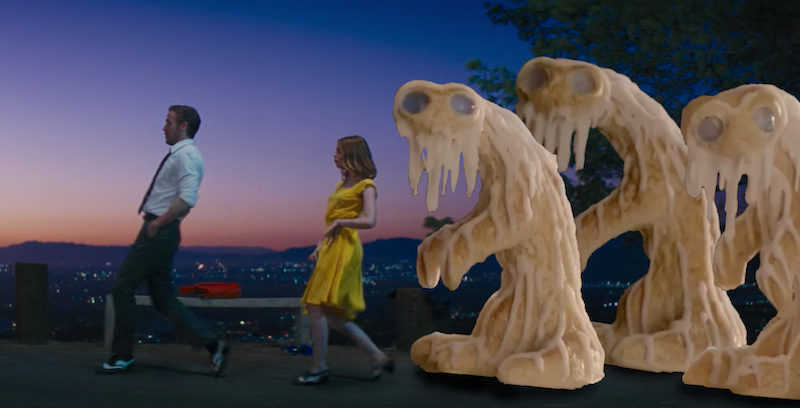"The Furniture" is our weekly series on Production Design. This is the first of two columns discussing this year's Oscar nominees. Here's Daniel Walber...

At a pool party in La La Land, Mia (Emma Stone) is granted the unique misfortune of being introduced to a generic Hollywood screenwriter. “I have a knack for world-building,” he says, instantly conjuring spectres of a Game of Thrones economy. Mia quickly extricates herself, destined for a different man in love with his own talent.
The moment is fleeting, but it peels back the curtain on Damien Chazelle’s own view of world-building and filmmaking. His version of Los Angeles isn’t at all overstated, with the exception of its ever-present automobiles. The characters don’t quite inhabit an identifiable city. Rather, they exist against a backdrop of imagined Hollywood, built from relentlessly colorful skies and busy studio lots...
You’d think the obvious comparison among this year’s Best Production Design nominees would be Hail, Caesar! You’d be right! But I’ve already written about it. Instead, let’s look at what La La Land’s self-contained fantasy shares with another boxed-in world: that of Fantastic Beasts and Where to Find Them.

That probably seems counter-intuitive, but bear with me. Both take place in iconic cities. Both do away with the real world almost entirely, either through music or magic. And, this being the crux of the argument, they both prioritize charming fantasy over the grainy depth of “world-building.”
Unlike the bleak, self-aware maturity of the last few Harry Potter films, Fantastic Beasts hearkens back to the earliest entries in the franchise. The work of production designers Stuart Craig and James Hambridge is refreshingly playful. Its magical settings are charming and ridiculous, from the Art-Deco office buildings to the cleverly decorated speakeasy.

The best set, however, is the interior of Newt Scamander’s suitcase. Putting Mary Poppins to shame, this wizard’s luggage can handle a miniature zoo. It has no relationship to the laws of physics, obviously. But it also has no internal logic, no fictional rules. It’s all a trick.

His pets are kept calm by sleight of hand, painted curtains that depict their natural habitats. The serengeti abuts the desert, and no one’s the wiser. There’s even a frozen wasteland. It is as if he has his own miniature Hollywood studio, into which he can move any kind of set.

Of course, we aren’t as gullible as Scamander’s pets. But that’s what makes his workshop so entertaining. Its sheer commitment to its own charade is the source of its charm, as gleeful as the matte paintings that enliven an old Hollywood’s dream ballets.

It is this same spirit that drives the triumphant finale of La La Land, itself a danced fantasy of a more glamorous life. Mia and Sebastian (Ryan Gosling) find themselves in a movie studio, a blank slate upon which their fantasies can come to life. Yet the ensuing backdrops never transcend the vibe of play-acting. The room always feels small, closed-off from the imagination. It has a charming affection for its own absurdity, but possesses little aesthetic commitment. It’s as if even the film doesn’t believe in its own capacity for wonder.

References to the stylistic flourishes of Singin’ in the Rain and An American in Paris are immediate and bright, but also thin and unexplored. Silhouettes, matte paintings, props and backup dancers all dance across the screen, but never unlock another world. The sets, especially those that represent Paris, anchor the characters in a paint-by-numbers pastiche, an ode to classic Hollywood musicals that never finds its specificity.

The one saving grace is the film’s central image, a simple set that dispenses with the trappings of both jazz and Hollywood entirely. As the ballet climaxes, Sebastian and Mia find themselves surrounded by stars, transparently false but still somehow infinite and heavenly. It’s a beautifully executed statement, the strongest defense of the film’s aesthetic. La La Land works best as a buoyant, if ill-advised love story. Its design is strongest when all the rest falls away.

Fantasy & Musical Highlights of The Furniture:
The Wonderful World of the Brothers Grimm (1962)
Beaches (1988)
Sleepy Hollow (1999)
Dreamgirls (2006)
Pan's Labyrinth (2006)